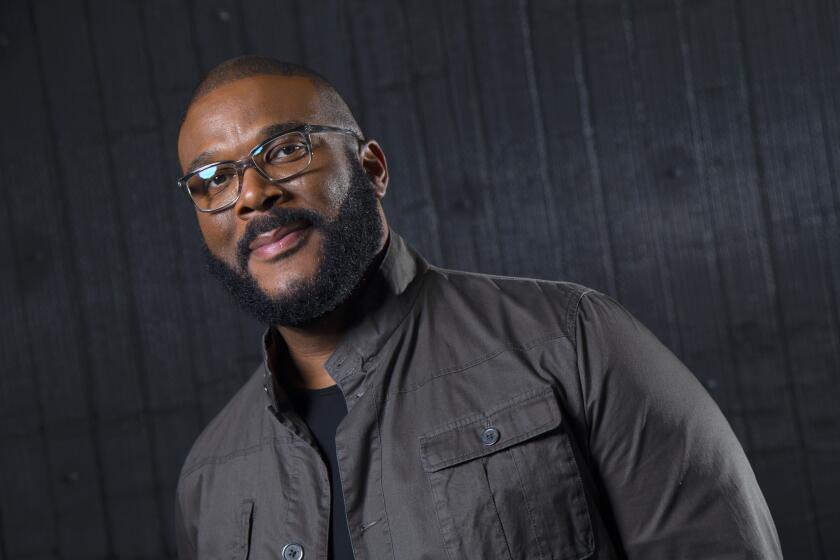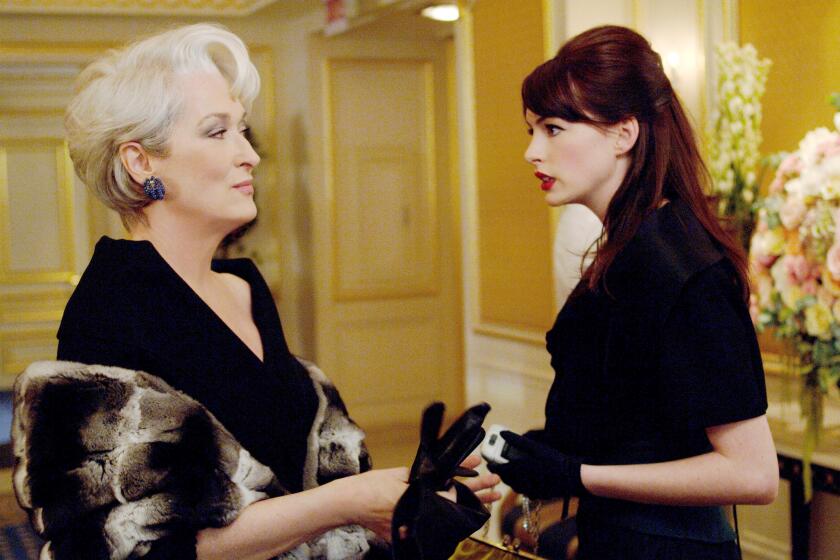SPARING RAMBO’S LIFE MADE SEQUEL POSSIBLE
- Share via
Marine veteran John Rambo had just refought the Vietnam War in a small town in Oregon and with his ammunition and his rage spent, he asked his former Green Beret commander to shoot him before the National Guard closed in.
“You made me, you kill me,” Rambo said. “Don’t let them do it.”
Col. Trautman aimed his gun but couldn’t pull the trigger. So the exhausted Rambo, in one quick final gesture, lunged forward, grabbed his hand and launched the fatal bullet himself.
The End.
Goodby Rambo. Goodby sequel. Goodby Tri-Star’s Summer of Content.
“We weren’t thinking sequel, we were just thinking about being fair to the audience,” says producer Andy Vajna, of the decision not to use the above ending for “First Blood,” the 1982 hit that made this summer’s blockbuster “Rambo” possible.
“We felt that if we were going to let the audience root for this guy for an hour and a half, we should spare him.”
The merciful judgment is one for which Vajna, his partner Mario Kassar and everyone else reaping the “Rambo” harvest will be forever grateful.
“First Blood” grossed $120 million from worldwide theatrical receipts, pay-TV licensing fees and videocassette sales. The follow-up has already taken in more than that from U.S. box-office receipts alone.
As Vajna points out, with barely concealed glee, action films make more money abroad than they do at home, and “Rambo” already is setting records from Holland to Australia.
“The unique thing is that sequels usually do about 60% of the original,” Vajna says. “With ‘Rambo,’ we are doing 300%, maybe 400%.”
The decision to make a sequel to “First Blood” was made within two weeks after the original’s release, Vajna says, and a second sequel--likely to bring Rambo back home for a political war--will go into production next year for release in the summer of 1987. If Stallone still has enough muscle to carry his share of profits, we may end up seeing as many “Rambos” as “Rockys.”
(Or maybe someone will put together the ultimate macho madness--”Rocky Meets Rambo,” starring Stallone in a conclusive dual role--after which Hollywood will simply shut down, like an old arena.)
Political and psychological analysts have been kept busy this summer trying to explain the success of “Rambo.” Even Vajna, after acknowledging that the sequel simply was made as an entertaining action adventure, suggests that the film taps into America’s resurging patriotism and gives us the kind of red-white-and-blue-blooded hero Hollywood hasn’t sent out since John Wayne hit the sands at Iwo Jima.
In Hollywood, the story is not why “Rambo” works but how Carolco Productions, the small independent company co-owned by Vajna and Kassar, got the first film made and then managed to keep most of the rewards for itself.
With both Orion Pictures, which distributed “First Blood,” and Tri-Star, which is distributing “Rambo,” Carolco is merely paying a fee for domestic distribution while maintaining all foreign, television and videocassette rights.
Vajna and Kassar, who previously made their livings representing American producers in overseas markets, were rummaging through unwanted projects with action storylines when they found “First Blood” at Warner Bros.
In 1972, the studio bought the rights from novelist David Morrell, who created and killed Rambo at the end of his ’72 best-seller. Though such directors as Martin Ritt, John Frankenheimer and Richard Brooks had been attached to it (also such actors as Al Pacino, Robert De Niro and--no kidding--George C. Scott for the Rambo role), it never came close to being made.
Vajna says they set out to make the picture the textbook way, by pre-selling foreign markets to cover most of their production costs, then to strike a deal with a major American distributor. But Stallone’s name had value then only as Rocky, and foreign buyers were wary.
Carolco decided to make “First Blood” with private financing. With interest rates topping 20%, the budget finally settled in at a throat-clutching $18 million. Vajna says they showed a 55-minute segment to buyers during the 1982 American Film Market in Los Angeles, and though foreign markets scooped up the film, the major studios still weren’t interested.
“Most of the studios are not acquisition-minded,” he says. “They are in-house production-minded, where the producer gets a salary and the studio owns everything.”
When the major studios acquire films from an independent film maker, says Vajna, they demand everything but his first-born child, and with less than half of its budget covered, Carolco couldn’t afford the deals being offered.
So, “First Blood” ended up at Orion, which was then a minor distributor with major ambitions.
Orion released “First Blood” in late October, when there was little competition, and it did an astounding $9 million during its opening weekend. By Christmas, when it was pulled from theaters, it had grossed more than $50 million.
Vajna is critical of the way Orion handled “First Blood,” saying the studio spent too little promoting it, waited too long to increase the number of prints, and then pulled it too soon from theaters.
Vajna struck virtually the same deal with Tri-Star as it had with Orion: Carolco retains everything, while Tri-Star gets a distribution fee.
No one will reveal the terms, but a normal distribution fee is about 30% of box-office receipts. With “Rambo,” which has grossed $142 million domestically, that would mean net profits of more than $30 million to Tri-Star, after the $8-million to $10-million it has spent for marketing the picture.
Meanwhile, Orion, which could have used a hit this summer, is shrugging off the sequel’s success as an opportunity it did not deserve to lose.
“We did very well with it (‘First Blood’),” said one Orion executive, who asked not to be named. “Nobody else wanted it when they brought it to us. Stallone’s largest gross outside ‘Rocky’ to that point was $9 million.”
Most likely, Vajna says No. 3 will end up at Tri-Star too.
“It’s rare to hear a producer praise a distributor,” he says. “But they (Tri-Star) really did a job with this movie.”
Financing the $27-million sequel was no problem, Vajna says. Most of the original participants returned for a second cut. Among them: HBO, which has domestic cable rights, and Thorn EMI, a British company that is handling videocassette sales as well as theatrical distribution in Europe.
It is a fat pie anyway you slice it, and another, even more expensive one will be out of the Carolco oven in two summers. And to think, it would have all ended had Rambo’s suicide been allowed to stand.
Or maybe not.
“If we had killed him,” Vajna says, with a Cheshire grin, “then there would have been a prequel.”
B.O. BLUES: Columbia Pictures’ summer slump continued with the dismal opening of “The Bride,” a romantic replaying of the classic 1935 “The Bride of Frankenstein.”
“The Bride” did only $1.8 million worth of business in 955 theaters, and didn’t even make it into the weekend’s top 10.
Tri-Star’s “Volunteers,” a Peace Corps comedy starring Tom Hanks and John Candy, was the strongest new release, grossing $5.2 million in 1,560 theaters. It trailed only “Back to the Future,” which has now earned $109 million in six weeks.
Michael Cimino’s comeback film, “The Year of the Dragon,” did $4.1 million for MGM/UA in 942 theaters. “Return of the Living Dead,” the only other new release last weekend, opened in 1,506 theaters and grossed $4.4 million.
More to Read
Only good movies
Get the Indie Focus newsletter, Mark Olsen's weekly guide to the world of cinema.
You may occasionally receive promotional content from the Los Angeles Times.










